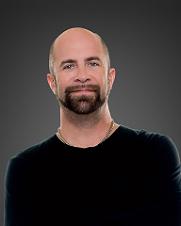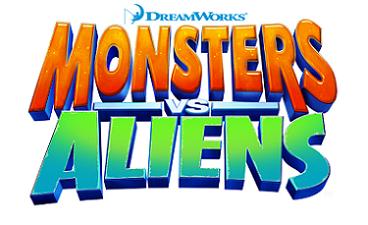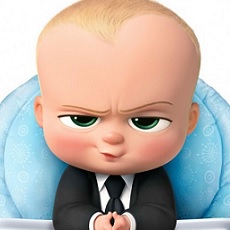 From mythology to cinema, from Leviathan to Godzilla, monsters have always been the metaphor of the fear for the destruction of the world, for wars or epidemics.
From mythology to cinema, from Leviathan to Godzilla, monsters have always been the metaphor of the fear for the destruction of the world, for wars or epidemics.
But…what if monsters could actually SAVE the world?
That’s the question DreamWorks Animation is presently asking through Conrad Vernon and Rob Letterman’s Monsters vs. Aliens. In this irreverent modern day action comedy reinventing the classic 50s and 60s monster movie, the world learns that the military has been quietly rounding up monsters over the years.
This ragtag group consists of the brilliant but insect-headed Dr. Cockroach, Ph.D.; the macho half-ape, half-fish The Missing Link; the gelatinous and indestructible B.O.B.; and the 350-foot grub called Insectosaurus. Their confinement time is cut short however, when a mysterious alien robot lands on Earth and begins storming the country.
As a last resort, under the guidance of General W.R. Monger (on a desperate order from The President), the motley crew of Monsters is called into action to combat the aliens and save the world from imminent destruction!
It was our pleasure to discuss this hilarious and smart movie with one of its directors, Conrad Vernon. A former CalArts student and storyboard artist on Antz, Shrek, The Road to Eldorado and Sindbad: Legend of the Seven Seas, he directed the Itsy Bitsy Spider TV series, Morto the Magician and Shrek 2. With Monsters vs Aliens, he directed his first “true 3D” movie.
It is with extreme kindness and generosity that he now shares his enthusiasm for the movie with us.

Animated Views: How did you get the idea of making the film?
Conrad Vernon: It came about when I was in Cannes, for Shrek 2, and I was given a script called Rex Havoc. It was about a monster hunter. I read the script and I wasn’t crazy about the story but I really liked the concept of it. So, I turned the script over and started writing down like we should do a movie about the 1950s monsters, like the old Ed Wood 50s sci-fi movies. That would be the concept where humor and satire would come from. So, I started kind of assembling the team and what monsters I’d like to see. Then, later on, my co-director, Rob Letterman came. He had gone to Jeffrey [Katzenberg] and said: “I want to do a ‘Dirty Dozen‘ movie”, and Jeffrey said: “Well, you should go talk to Conrad because that story idea would work great with what he’s doing”. So, we kind of put our ideas together and came up with what Monsters vs Aliens is.
 AV: How did you build your story in terms of the different characters that you selected out of the old 50s sci-fi figures?
AV: How did you build your story in terms of the different characters that you selected out of the old 50s sci-fi figures?
CV: DreamWorks actually gave us a budget to go out and buy as many old horror sci-fi films as we wanted. So, we got like 150 of them, something like that. All from the 50s, 60s and even early 70s. So, we bought all these films and we had that library of films that we could go reference. Out of all those films, we realized that there were certain characters that stood out as the quintessential 1950s and 60s B-movie characters. That were the Human Fly, the Creature from the Black Lagoon, the Blob, Godzilla and the 50 Foot Woman. And we said: “let’s make our own version of those characters”. Because most people will recognize that type of monster.
AV: After Kung Fu Panda last year, which was very different from DreamWorks’ previous productions, is MvA a way to go back a more classic DreamWorks kind of humor, based on pop cultural references, like Shrek?
CV: I guess it’s more a way of doing satire. Whenever you’re satirizing something, you’re kind of referencing that whether it’s something specific or even a genre of something. Shrek was satirizing fairytales and pop culture, and we’re satirizing more the old B-movie monsters. Kung Fu Panda referenced Kung Fu movies, and didn’t satirize them. There’s a fine line between satirizing and paying homage. And usually, you satirize something because you like it; you want to make something like it because it’s influenced you in some way. You just turn over it and try to make it interesting and funny.

AV: One way or another, was Monsters, Inc. part of your references?
CV: First of all, the last thing we’d ever want to do is steal and idea or copy anything. But, obviously, we were dealing with monsters, so Monsters, Inc. came to our mind and we said: “ok, we need to stay away from that.” Also, when we started working on this movie, I guess we were about probably a year/a year and a half into making the movie, and The Incredibles came out, with a team of superheroes. We had a team of monsters. So, we saw that movie and made sure we moved away from that. You know, we want to be original and unique and make sure that what we put up there is something people have never seen before. That’s definitely a very big goal in our minds to do that. So, when you’re thinking about our monsters and Monsters, Inc., I think they have a different style to them. They’re not the nightmares in the closet. They’re the cheesy, funny monsters you see in the old movies.
 AV: Despite all these references, your film addresses a contemporary audience. So, how did you manage to reference to 50s movies and make your movie “present-day” at the same time, which is part of the humor of it, too?
AV: Despite all these references, your film addresses a contemporary audience. So, how did you manage to reference to 50s movies and make your movie “present-day” at the same time, which is part of the humor of it, too?
CV: There was a thought, in the beginning, to set this in the 60s but we didn’t want to have to deal with: what was happening then? who was around then? What did they wear then? We didn’t want to literally set it in the 60s. My first thought was to say: “ok, what was the cartoon style they had back then?”. I was a huge fan of Mad Magazine when I was a kid. So, I said: “let’s start there. Let’s look at the cartooning styles of the 1950s and 60s and see what was prevalant in the design thought back then.” So, we looked at Mad Magazine and a lot of other things like the movie posters from the 1950s and 60s horror films.
We just took references from each of these and started creating our own design language for the movie. You know, we heavily were influenced by Jack Davis because he had a very interesting way of caricaturing people and a cartoony style that is still giving them a human feel, and I think that’s where we got our style for the humans. As far as making it in present-day, all the cars and all the look of the technology is all from present-day. For instance, back in the 60s, whenever you saw a computer, you saw those giant reels of recording tape. We could have easily put that type of technology up there, but we wanted to make sure that it was present-day. Cars, restaurants, the looks of buildings, the technology that’s in the movie let you know it’s happening now.
AV: From Reese Witherspoon to Kiefer Sutherland, you appealed to an amazing cast of voice talents. But being myself a big House fan, I can’t but ask you more specifically about your collaboration with Hugh Laurie!
CV: He was great. He came in very early on and we pitched him the character. Once he saw the character and all the artwork that we were doing, he really took a shine to it. We did that with all the actors, but Hugh came in and started really thinking about how smart this guy was. And what’s great about Hugh: he’s really that intelligent, as far as Dr. Cockroach is concerned. He was just quoting Jane Austen off the top of his head as he was acting. And he came up with the name “Phileas J. Cockroach”: he gave Dr. Cockroach his first name! It was really great to watch him go in there and go from astute, pompous scientist who’s the most brilliant man in the world into a cackling, mad scientist laugh, and then regaining his composure instantly, and also coming up with all those really intelligent stuff to say, that really gave the character its foundation. He’s really an amazing performer!

 AV: How did you elaborate the animation for all those creatures that don’t exist in the reality?
AV: How did you elaborate the animation for all those creatures that don’t exist in the reality?
CV: With any animated film, you kind of explore a character and the personality that they have in the way they move, and I think all the characters – except for Bob and Insectosaurus – walk on two legs. So, it’s just a question of: what’s their personality? How do they walk on two legs? We did animation tests on every character. So, for instance, Dr. Coackroach was astute and stood up straight and walks very purposefully across the room and is always thinking. So, we had a very special way for him to move, not just walk but to stop and think and use his hands. Link is more of a macho and we also said: “let’s make him walk on all fours, like an ape, and then be able to sit on his knuckles and swing himself around.”
Bob was actually a challenge because it was done half in character animation and half in effects animation. Whenever he moves across the room and talks and acts, it was a character animation job, but then they passed it over to effects whenever he needed to get a strange shape or split in half or loose his eyeball or explode or anything like that. With Insectosaurus, because we wanted to do kind of a Godzilla thing with him, we wanted to animators to pretend that this was monster that was a rubber suit with a guy inside of it. His pinches are just kind of flopping by his side, he really doesn’t have any facial expression or anything, he’s just kind of like this big, lumbering, rubber suit walking around. We wanted that to be part of his character.
And then, of course, Susan is just a human being. But we also had to think about how would a person feel walking through a tiny town, with fragile buildings and street lamps around. If she accidentally stepped on a car, what would happen? How would they react? So, we actually had one of our animators. We built a small model city and we put little cars and trees and street lamps and everything down the streets of this little city. We took a video camera and shot her coming around the corner and walking down that tiny street. She did accidentally step on a couple of the cars and went: “oh! Sorry!”, and we said: “no, that’s what we want!” It was interesting, just figure out how clumsy and out of place a human being that was 50 feet tall would feel.
 AV: Did you develop much in pre-viz, like they did on Kung Fu Panda?
AV: Did you develop much in pre-viz, like they did on Kung Fu Panda?
CV: We did. Like Kung Fu Panda, our action scenes are heavy ones. They’re real action scenes, they’re fast cutting, we have a lot of different shots going by very quickly, and very rarely are those ever storyboarded out and thought out. So, pre-viz gave us a choice of a lot of different angles and a lot of different shots to choose from before we go and animate it. It also helped immensely to be able to see the entire scene and figure what was working, what wasn’t working in the scene and then be able to cut out what wasn’t working and put in new shots – because the layout department, they were just dealing with camera. So, it was a lot easier than redo the camera. And we’re the first 3D movie for DreamWorks so, it was nice to be able to look at the previsualization in 3D, see what 3D shots were comfortable, what worked, what didn’t work about the 3D and then go back and change that to make it just absolutely perfect before it went to animation. It was a little bit of back and forth, but a lot less than it would have been.
AV: Did the 3D influence the way you conceived a scene, or was it just a narrative tool to serve your story?
CV: The answer is kind of both. When we first heard we were going into 3D in this film, we – my directing partner and the producers and Jeffrey – decided that we weren’t gonna use 3D just to poke that out of the audience and to make them go “waaooo!” So, the first and foremost rule we gave us was to tell the story and use the 3D to help tell the story. So, in that sense, it didn’t change what we did. But, as we would go into pre-viz, we started saying: “ok, are there shots that we can sweeten in order better use the 3D, that won’t ruin the storytelling?” And there were some shots that we would either lengthen or we would deepen the 3D or pop things out a little more off the screen because the story was enhanced by doing that. So, there were a few shots throughout, but it didn’t change the way we made the entire film, and it certainly didn’t change the storytelling. The 3D was just added to enhance it.
 AV: What kind of supplemental work did 3D demand, compared to your previous directorial experiences?
AV: What kind of supplemental work did 3D demand, compared to your previous directorial experiences?
CV: I guess the easiest way to put it is: in these animated films, there are very clear steps or phases. All these phases are being executed at the same time. But, each phase starts at a very specific time. So, for instance, you start with an outline or the beginnings of a script. Once that’s started and you have a scene that you think captures the tone and the story of the movie, you start storyboarding that out. Then the script and the storyboard are going. Then, you go into pre-viz with that first scene, and then all three of these things are going. Then, you go into Animation, then you go into Lighting, then you go into Effects Animation. And then, at one point, all these actions are going at the same time to make the movie. 3D is just one step on top of that, but that’s something that would permeate every single one of those steps except for the script and storyboarding phases. Once we went into pre-viz, for the rest of the steps – Animation, Lighting, Effects – we would be wearing those glasses looking at it 3D, making sure it was a comfortable and impressive viewing experience.
AV: What was the most challenging element to put into 3D?
CV: It’s hard to say because I’m sure the head of each department would say 3D was a pain in the butt for this or for that. But my view on it is: when we were doing Shrek 2, or any movie that wasn’t in 3D, we had the ability to use matte paintings. For instance, in Shrek, there was a bunch of shots where Donkey and Shrek were traveling from the swamp to Far, Far Away and you saw this big distance of them going up a mountain and going across a field and you just saw this huge shot of background as the carriage is going. In 2D, you just do a painting and you put some effects on top of that, animate a couple of trees blowing and that’s it.
In 3D, you have to build every single tree, the mountains, the fence. You have to build this entire city, for example, because you’ll see the 3D stop if you have a matte painting there. It’ll look like a backdrop, like a sheet, and they’re acting in front of a sheet. So, the modelers had to literally go in and build the entire area that we were going to shoot. 3D totally ruins that visually trick of using a matte painting. Now, we have to go in there and build everything. We literally don’t have to build 15 miles away, but we have to put some geometry in there and map it with something so that it sticks out in 3D like everything else on the screen.

AV: Henry Jackman is certainly one of the most promising composers of the time. How did you work with him on the film?
CV: It was a very collaborative and back and forth process. It was really great. Henry is an ultimate professional. He’s an amazing, talented composer. I’m not saying that just to blow smoke. He really is! I really enjoyed working with him. There was a very fine balance between doing horror movie music – which is what we started out with – and making sure that it wasn’t too grim or scary. We were making a comedy-action film, so we wanted to make sure that the music reflected and not the sheer terror constantly.
We went in and started to just play around with tones of music. He started out with horror music and then we said: “ok, how do we lighten this up?”. And then we went to action type of music and we said: “that’s too ‘action’; we still need that little bit of horror in there.” So, I think Henry found a really great balance when we started to play around themes for each character. Especially Susan’s theme. When he wrote Susan’s theme, it kind of fit everything so perfectly, and he started writing a suite where you take that theme and you would do it “happy”, and you would do it “sad” and you would do it “action” and you would do it “horror”, and it would kind of blend in and out of each of these themes as the story was being told. So, we kind of used that as our basis. That set our style and we just added onto that.
For instance, he did the same thing with Gallaxhar. He wrote a theme for Gallaxhar and then did a small suite of this Gallaxhar’s theme while he’s talking, when he thinks evil, when he’s very angry, when he’s victorious… That gave us the whole idea for the aliens, and laid the foundations there. So, we kind of worked in sections like this. There was a monsters’ theme –we didn’t want to have direct ones for Link and Insectosaurus and Bob and Dr. Cockroach. We wanted to use them as a group. So, Henry wrote a theme for the group of monsters and did a suite for that. Once we had all these pieces down, Henry went in and just put them together seamlessly – and that just made the score! He did a great job!

AV: Now that Monsters vs Aliens is completed, have you started working on your next for DreamWorks, Route 66?
CV: No. Route 66 is back in development and my writing partner on that project, Harland Williams, is doing a new take on it. He’s re-writing it. They have another idea they want to go with as far as that project is concerned, and he’s doing that right now.
AV: What do you walk away with from your MvA experience?
CV: Just an amazing and a spectacular film (that was the word everyone said after watching the movie). I’m super-proud of what we’ve accomplished. You look at the final product and it’s just so mind-blowing and also engaging as far as the characters are concerned. You can’t help just have a real sense of accomplishment and pride in what you do for a living and how lucky I am to have been able to do this for a living, and actually do something that I’m proud of and find really entertaining. That was my goal when I started in this business: to entertain people. This film, I think, does that very, very well. It kind of fulfilled every goal I’ve ever set out for myself as far as animation is concerned!
Our thanks go to Conrad Vernon and David Hail.







